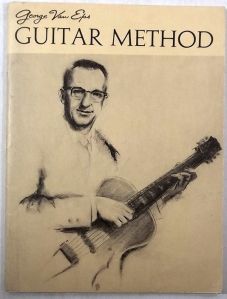George Van Eps – Method For Guitar
George Van Eps was one of the greatest guitar players of the 20th century (1913-88) – just ask any jazz guitar player. Although he was an early pioneer of the 7-string guitar, much of his published work is for six strings. He encapsulated his understanding of the guitar in three HUGE volumes, Harmonic Mechanisms for Guitar.
The publicity blurb for this book states:
“The most in-depth, revolutionary presentation of the harmonic framework of music is applied to the guitar fingerboard ever presented. Leads to total mastery of harmonic and technical aspects of the guitar. The material in this landmark series of 3 massive volumes address virtually every aspect of playing jazz guitar representing the fruits of years of the author’s investigation of harmony and fingerboard mobility. This series of books leads to total mastery of the harmonic and technical aspects of the guitar.”
One day I might tackle the lower slopes of that mountain. But thankfully Van Eps wrote a slim Method for Guitar in the late 1930s, and although not as highly regarded as the Harmonic Mechanisms, it still has a lot to teach us.
Check out what Matt Warnock has to say about Mr Van Eps: LINK
I am making a survey of classic early jazz guitar tutors, and could not ignore one written by the colossus which is George Van Eps. I suggest you make the exploration with me…
1st Step – Buy the book – original copies can still be found…
Here’s the cover of the Mel Bay edition, which I managed to find on ebay!:
Or it can be downloaded for (last time I looked) $10 from Django Books
2nd Step – Get to work!
Here are a few videos I’ve made to help you along, if you need help, that is.
N.B. I give Skype lessons. Contact me if interested:
robmackillop AT gmail DOT com.
Ex.1 Form 1:
GVE starts by showing us six “formations” of chords in the key of C Major. Each formation has a different arrangement on the fretboard. He asks us to transpose these to all 12 keys.
Ex.1 Form 2:
Ex.1 Form 3:
Ex.1 Form 4:
Ex.1 Form 5:
Ex.1 Form 6:
Ex.3: Here we learn an arpeggio picking method which GVE wants us to master and use on all these exercises. I think he picked this up from his father (who was a great banjo player), as it is a staple technique for the early plectrum banjo.
Ex.10: Here GVE extends the scale above the high tonic…
Ex.11: and below…
Ex.12 Form 1 – here we have three forms in the key of D, though all keys are to be explored.
Ex.12 Form 2
Ex.12 Form 3
Ex.14: The important point here is to sustain the notes. This will become more important when we try to extract melodies from chords, and play counterpoint.
Ex.15
Ex.16: Jazz guitar players are often called on to flatten the last joint of their left-hand fingers, in what might be described as mini barres. This is a very important technique:
“With Minor Chords”
Here Van Eps introduces a few different takes on chords of the minor scales. Form 26 is the harmonic minor. Form 27 has the ascending form of the melodic minor, but with the the harmonic minor in descent. Form 30 is the melodic minor – sharp going up, flat coming down.
Ex.26 Form 1 – I add a few rhythmical variations here. Why not try a few of your own?
Ex.26 Form 2
Ex.26 Form 3
Ex.26 Form 4
Ex.26 Form 5
Ex. 26 Form 6
Ex.27 Complete – Six Forms
Ex.30 Complete – Here I give a little introduction to the melodic minor scale. There is a mistake in the notation for the 4th Form – the first string is not to be used.
“With Seventh Chords”
Ex.33 and 34 Complete – I have a not quite so deliberate mistake in the video of Ex.34 Form 2: the 4th chord should be on the top three strings at the 5th and 7th frets. Sorry about that. There are mistakes in the printed score as well, with the indications for string sets in Ex.34…
Form 1 – Top notes are on strings 4 in the first bar, then string three for two bars, then string 2, and finally string 1. This could be notated as: 4 3 3 2 1
Form 2 – 4 3 3 1 1 (I play 4 3 3 2 1). Also, there is a sharp sign missing for the f in bar 2.
Form 3 – 4 4 3 2 1
Form 4 – 4 3 2 1 1
“With Diminished Chords”
Ex. 48 to 52 Complete
Ex.53, 55, 56 and 58
Ex.60 to 66
More explorations of the diminished chord…
Ex67 and 68 -Try to sustain the bass notes in Ex.68 – not easy when the bass is on the 5th string…
Ex.69
A nice chord sequence to play with…
Etude Study, page 40 – this is from the last page in the book. I make a point of mentioning I am using Van Eps’ left-hand fingering, as there are places where a much simpler solution could be used, but it is his study, after all…Good luck with this one!



